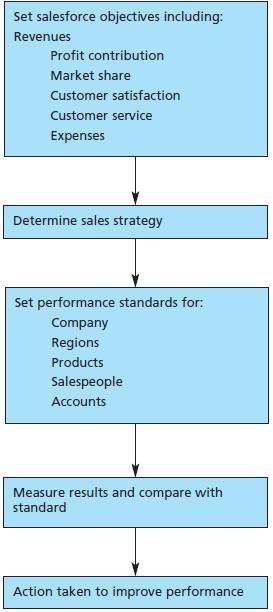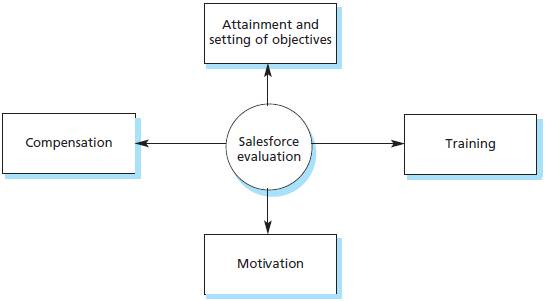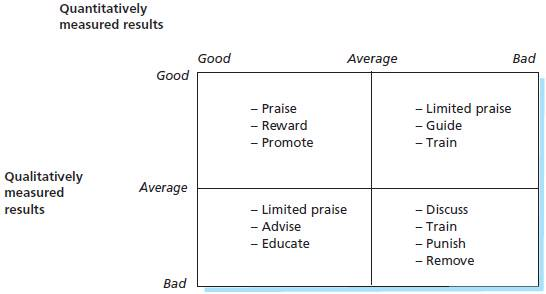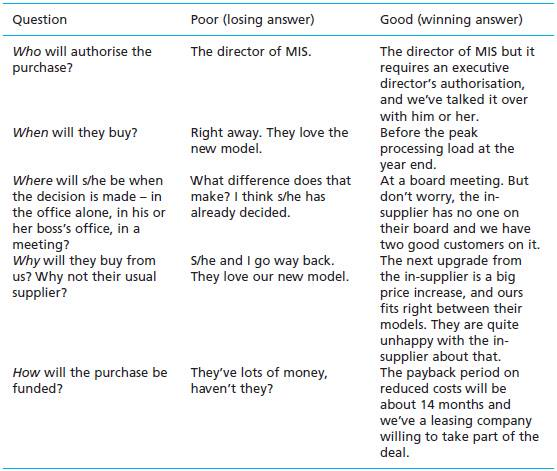Topic Introduction:
Salesforce evaluation is the comparison of salesforce objectives
with results.
Topic Overview:
1. Model of Salesforce
Evaluation
A model of the evaluation process is shown in figure below. It
begins with the setting of salesforce objectives which may be financial, such
as sales revenues, profits and expenses; market-orientated, such as market
share; or customer-based such as customer satisfaction and service levels.
Then, the sales strategy must be decided to show how the objectives are to be
achieved. Next, performance standards should be set for the overall company,
regions, products, salespeople and accounts. Results are then measured and
compared with performance standards. Reasons for differences are assessed and
action taken to improve performance.

[Figure: The salesforce
evaluation process]
2. The Purpose of
Evaluation
The prime reason for evaluation is to attempt to attain company
objectives. By measuring actual performance against objectives, shortfalls can
be identified and appropriate action taken to improve performance. However,
evaluation has other benefits. Evaluation can help improve an individual’s
motivation and skills. Motivation is affected since an evaluation programme
will identify what is expected and what is considered good performance. Second,
it provides the opportunity for the recognition of above-average standards of
work performance, which improves confidence and motivation. Skills are affected
since carefully constructed evaluation allows areas of weakness to be
identified and effort to be directed to the improvement of skills in those
areas.
Thus, evaluation is an important ingredient in an effective training
programme. Further, evaluation may show weaknesses, perhaps in not devoting
enough attention to selling certain product lines, which span most or all of
the sales team.
Evaluation provides information which affects key decision areas
within the sales management function. Training, compensation, motivation and
objective setting are dependent on the information derived from evaluation, as
illustrated in figure below. It is important, then, that sales management
develops a system of information collection which allows fair and accurate
evaluation to occur.

[Figure: The central
role of evaluation in sales management]
3. Setting Standards
of Performance
Evaluation implies the setting of standards of performance along
certain lines which are believed to be important for sales success. The control
process is based upon the collection of information on performance so that
actual results can be compared against those standards. For the sales team as a
whole the sales budget will be the standard against which actual performance
will be evaluated. This measure will be used to evaluate sales management as
well as individual salespeople. For each salesperson, his or her sales quota
will be a prime standard of sales success.
Standards provide a method of fairly assessing and comparing
individual salespeople. Simply comparing levels of sales achieved by individual
salespeople is unlikely to be fair since territories often have differing
levels of sales potential and varying degrees of workload.
4. Gathering Information
The individual salesperson will provide much of the information
upon which evaluation will take place. S/he will provide head office with data
relating to sales achieved by product/brand and customer, a daily or weekly
report of the names of customers called on and problems and opportunities
revealed, together with expense claims.
Such information will be supplemented by sales management during
field visits. These are important in providing more qualitative information on
how the salesperson performs in front of customers as well as giving
indications of general attitudes, work habits and degree of organizational
ability, all of which supplement the more quantitative information provided by
the salesperson.
Market research projects can also provide information on the sales
team from customers themselves. A specific project, or a more general one which
focuses on the full range of customer–seller relationships, e.g. delivery,
product reliability, etc., can provide information on salespeople’s performance.
5. Measures of
Performance
5.1 Quantitative Measures of Performance
Assessment using qualitative performance measures falls into two
groups. For both groups, management may wish to set targets for their sales
team. One group is a set of input measures which are essentially diagnostic in
nature – they help to provide indications of why performance is below standard.
Key output measures relate to sales and profit performance. Most companies use
a combination of input (behavioural) and output measures to evaluate their
salesforces. Specific output measures for individual salespeople include the
following:
·
Sales
revenue achieved
·
Profits
generated
·
Percentage
gross profit margin achieved
·
Sales
per potential account
·
Sales
per active account
·
Sales
revenue as a percentage of sales potential
·
Number
of orders
·
Sales
to new customers
·
Number
of new customers
All of these measures relate to output.
The second group of measures relates to input and includes:
·
Number
of calls made
·
Calls
per potential account
·
Calls
per active account
·
Number
of quotations (in part, an output measure also)
·
Number
of calls on prospects
5.2 Qualitative Measures of Performance
Assessment along qualitative lines will necessarily be more
subjective and take place in the main during field visits. The usual dimensions
which are applied are given in the following list:
·
Sales
skills -
These may be rated using a number of sub-factors:
®
Handling
the opening and developing rapport.
®
Identification
of customer needs, questioning ability.
®
Quality
of sales presentation.
®
Use
of visual aids.
®
Ability
to overcome objections.
®
Ability
to close the sale.
·
Customer
relationships:
®
How
well received is the salesperson?
®
Are
customers well satisfied with the service, advice, reliability of the
salesperson, or are there frequent grumbles and complaints?
·
Self-organisation: How well does the
salesperson carry out the following?
®
Prepare
calls.
®
Organize
routing to minimize unproductive travelling.
®
Keep
customer records up to date.
®
Provide
market information to headquarters.
®
Conduct
self-analysis of performance in order to improve weaknesses.
·
Product
knowledge: How well informed is the salesperson regarding the following?
®
His
or her own products and their customer benefits and applications.
®
Competitive
products and their benefits and applications.
®
Relative
strengths and weaknesses between his or her own and competitive offerings.
·
Co-operation
and attitudes: To what extent will the salesperson do the following?
®
Respond
to the objectives determined by management in order to improve performance,
e.g. increase prospecting rate.
®
Co-operate
with suggestions made during field training for improved sales technique.
®
Use
his or her own initiative.
·
What
are his or her attitudes towards the following?
®
The
company and its products.
®
Hard
work.
An increasing number of companies are measuring their salespeople
on the basis of the achievement of customer satisfaction. As Richard Harrison,
a senior sales manager at IBM, states: ‘Our sales team is compensated based on
how quickly and how efficiently they achieve customer satisfaction’.
Sales management response to the results of carrying out
salesforce evaluation is shown in figure below. Lynch suggests four scenarios
with varying implications:
·
Good
quantitative/good qualitative evaluation: The appropriate response would be praise
and monetary reward. For suitable candidates promotion would follow.
·
Good
quantitative/poor qualitative evaluation: The good quantitative results suggest that
performance in front of customers is good, but certain aspects of qualitative
evaluation, e.g. attitudes, report writing and market feedback, may warrant
advice and education regarding company standards and requirements.
·
Poor
quantitative/good qualitative evaluation: Good qualitative input is failing to be
reflected in quantitative success. The specific causes need to be identified
and training and guidance provided. Lack of persistence, poor closing technique
or too many/too few calls might be possible causes of poor sales results.
·
Poor
quantitative/poor qualitative evaluation: Critical discussion is required to agree
problem areas. Training is required to improve standards. In other situations,
punishment may be required or even dismissal.

[Figure: Salesperson
evaluation matrix]
For an evaluation and control system to work efficiently, it is
important for the sales team to understand its purpose. For them to view it
simply as a means for management to catch them out and criticize performance is
likely to breed resentment. It should be used, and be perceived, as a means of assisting
salespeople in improving performance. Indeed, the quantitative output measures
can be used as a basis for rewarding performance when targets are met. In
essence, controls should be viewed in a positive manner, not a negative one.
5.3 Winning or Losing Major Orders
A key qualitative evaluation question that sales managers have to
ask is: ‘Does it appear that we are going to win or lose this order?’ This is
particularly important for major sales. For example, a sales manager may be
asked by the managing director: ‘Will you find out whether the Saudis are
really going to place that new big aero engine order? I have to tell the board
next week so that we can decide whether we will have to expand our plant.’
The obvious response would be to ask the salesperson in charge of
the sale directly. The problem is that many salespeople delude themselves into
believing they are going to be successful. How do you come to terms with the
fact that you are going to lose an order worth £5 million? Asking the direct question
‘Bill, are we going to win this one?’ is likely to get the answer ‘Yes, the
customer loves us!’ What the salesperson really means is that the customer
likes the salesperson, not necessarily the product.
Consequently the sales manager needs to probe much more deeply in
order to assess the situation more accurately. This involves asking a series of
who, when, where, why and how questions. It also means that the sales manager
needs to work out what would be considered acceptable (winning) answers, and what
would be thought of as unacceptable (losing) responses. Table below gives an
example of the use of this procedure in connection with a £10 million computer
sale. The losing answers are thin and unconvincing (e.g. the director of MIS
would not have the power to authorize an order of this size).

[Table: Winning and
losing orders]
The salesperson is deluding him- or herself and misleading the
sales manager. The winning answer is much more assured and provides clear,
credible answers to all of the questions (e.g. an executive director is likely
to have the power to authorize a purchase of this magnitude).
If the outcome is a losing answer, the sales manager has to decide
how important the sale is and how important the salesperson is. If they both
have high potential, the sales manager, sales trainer or top salesperson should
work with him or her. S/he should be counseled so that they understand why they
are being helped and what the sales manager hopes they will learn. In the
process, they will also realize that management cares about their development
and the success it can bring to both parties.
If the salesperson is viewed as having high potential but the
situation has low potential, only a counseling session is needed. Usually it is
best done at the end of the day, driving back from a call, using an ‘oh, by the
way’ introduction, and avoiding serious eye contact. By these means the
salesperson’s ego is not offended. When the salesperson does not have high
potential but the sale does, the alternatives are a little nastier. Perhaps the
salesperson would be a candidate for redeployment to a more suitable post. When
neither the salesperson nor the sale has much potential, the basic question is
whether the salesperson is redeployed before or after the sale is lost.
6. Appraisal
Interviewing
Appraisal interviewing can provide the opportunity to identify a
salesperson’s weaknesses and to give praise when it is deserved. One method is
to ask the salesperson to write down 5–10 expectations that they hope to achieve
during the next year, e.g. to go on a presentation skills course, to go on a
time management course, to have monthly sales visits from their sales manager,
to meet targets, to move into marketing, etc. The sales manager then sits down
with the salesperson and goes through this list, breaking it down into
quarterly (three-month) sections. At the end of each quarter they have another
meeting to see if expectations have been met or shifted in any way. These
meetings also provide an opportunity to give or withdraw recognition and
acceptance.

No comments:
Post a Comment